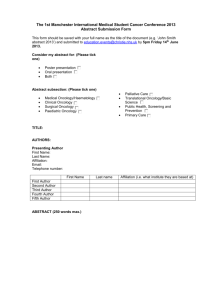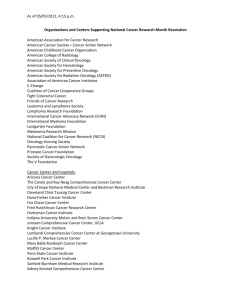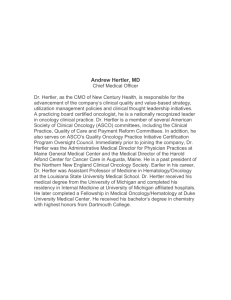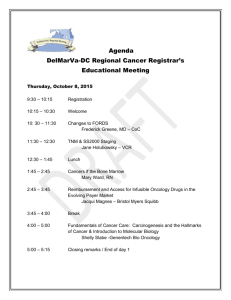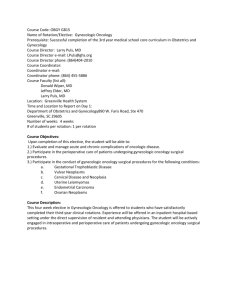Hematology and Clinical Oncology
advertisement
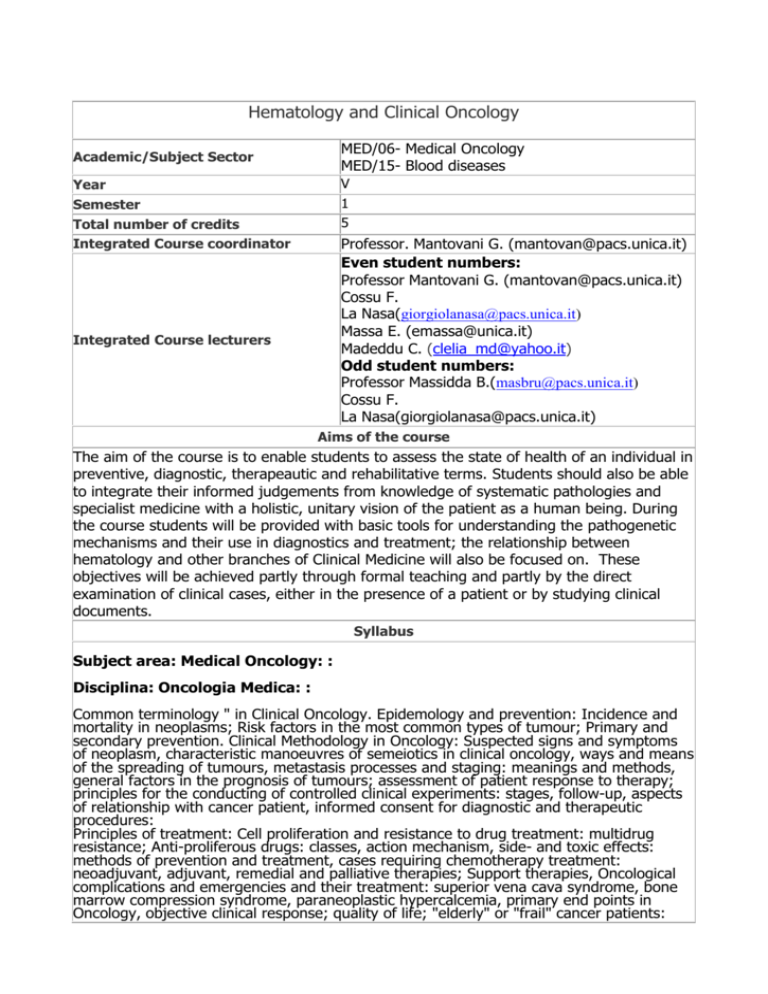
Hematology and Clinical Oncology MED/06- Medical Oncology MED/15- Blood diseases Academic/Subject Sector V Year Semester 1 5 Total number of credits Professor. Mantovani G. (mantovan@pacs.unica.it) Even student numbers: Professor Mantovani G. (mantovan@pacs.unica.it) Cossu F. La Nasa(giorgiolanasa@pacs.unica.it) Massa E. (emassa@unica.it) Madeddu C. (clelia_md@yahoo.it) Odd student numbers: Professor Massidda B.(masbru@pacs.unica.it) Cossu F. La Nasa(giorgiolanasa@pacs.unica.it) Integrated Course coordinator Integrated Course lecturers Aims of the course The aim of the course is to enable students to assess the state of health of an individual in preventive, diagnostic, therapeautic and rehabilitative terms. Students should also be able to integrate their informed judgements from knowledge of systematic pathologies and specialist medicine with a holistic, unitary vision of the patient as a human being. During the course students will be provided with basic tools for understanding the pathogenetic mechanisms and their use in diagnostics and treatment; the relationship between hematology and other branches of Clinical Medicine will also be focused on. These objectives will be achieved partly through formal teaching and partly by the direct examination of clinical cases, either in the presence of a patient or by studying clinical documents. Syllabus Subject area: Medical Oncology: : Disciplina: Oncologia Medica: : Common terminology " in Clinical Oncology. Epidemology and prevention: Incidence and mortality in neoplasms; Risk factors in the most common types of tumour; Primary and secondary prevention. Clinical Methodology in Oncology: Suspected signs and symptoms of neoplasm, characteristic manoeuvres of semeiotics in clinical oncology, ways and means of the spreading of tumours, metastasis processes and staging: meanings and methods, general factors in the prognosis of tumours; assessment of patient response to therapy; principles for the conducting of controlled clinical experiments: stages, follow-up, aspects of relationship with cancer patient, informed consent for diagnostic and therapeutic procedures: Principles of treatment: Cell proliferation and resistance to drug treatment: multidrug resistance; Anti-proliferous drugs: classes, action mechanism, side- and toxic effects: methods of prevention and treatment, cases requiring chemotherapy treatment: neoadjuvant, adjuvant, remedial and palliative therapies; Support therapies, Oncological complications and emergencies and their treatment: superior vena cava syndrome, bone marrow compression syndrome, paraneoplastic hypercalcemia, primary end points in Oncology, objective clinical response; quality of life; "elderly" or "frail" cancer patients: methods of assessment and principles of treatment; Specific area: principles of diagnosis and treatment staging, treatment applications and expected results for the following neoplasms, chosen on the basis of frequency of occurrence,exemplary nature and feasibilty of treatment; Pulmonary neoplasm; Colon and rectum neoplasm; Breast neoplasm, gynecological neoplasms: Ovary neoplasm, cervical and endometrium neoplasm; Prostate and testicle cancers; head and neck neoplasms; Hodgkins and nonHodgkins lymphomas. Subject area: Oncological radiotherapy Radiosensitivity and curability of tumours; Choice of total and single dosages; Combination of radiotherapy with surgery and chemotherapy; Choice of treatment techniques (external beam irradiation and curietherapy); Radiotherapy treatment programme; Function and role of relations with hypertemia; Indications for the use of heavy particles; Sequence of treatment and therapy in radio-induced lesions; The role of radiotherapy in common localised tumours (skin, pharynx, larynx, oral cavity, breast, lung, oesophagus, bladder, prostate, testicle, uterine cervix, endometrium, malignant lymphomas, central nervous system, radiotherapy for metastases). Subject area: Hematology Hematopoiesis; Kinetic classification of anemias: Megaloblastic Anemias, Iron-deficiency anemia, Protein-deficiency anemia, Anemia from chronic phlogosis, Vit.B6 deficiency anemia; Hemolytic diseases: spherocytosis, Elliptocytosis, G6PD deficiency. Anemias from metabolic malfunction (G-6-PD deficiency), Post-infection anemias, Immunohemolytic anemias; Beta-thalassemia, Alfa-thalassemia, Structural hemoglobinopathies. Chronic myeloproliferative disorders: polycythemia vera, essential thrombocythemia, idiopathic myelofibrosis; Chronic myeloid leukemia; Primary and secondary myelodysplasias. Acute leukemias; Chronic lymphoproliferative disorders: chronic lymphatic leukemia, tricholeukemia, lymphomas, Hodgkin's disease, Myeloma, Immunocytomas, Monoclonal gammopathy; Bone marrow aplasia and peripheral cytopenias; Hemostasis pathology, Coagulation and Fibrinolysis; Blood transfusion and Bone marrow transplants. Reference texts Bonadonna-Robustelli della Cuna "Medicina Oncologica" - Editore Masson; Cavalli, Hansen, Kaye "Texbook of medical oncology", 2nd Edition, Dunitz - Sante Tura, Lezioni di Ematologia, Ed. Esculapio. Teaching methods Assessments methods Multiple choice test followed by an oral exam Requirements to take the exam Language of instruction Reference texts Interactive teaching centre: Cattedra di Oncologia Medica, Policlinico Universitario Further information
